-
To all the moms out there protecting babies and hogging wild bird feeders…
We Wish You a Very Happy Mother’s Day!
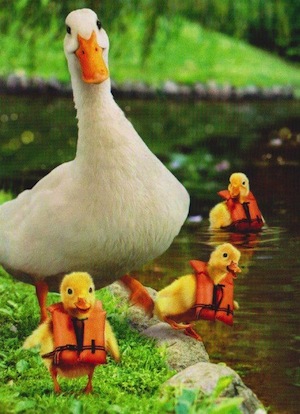 Whether they’re 2, 12, or 22, they’ll always be your babies, and we salute all Moms today!
Whether they’re 2, 12, or 22, they’ll always be your babies, and we salute all Moms today!It’s the innate characteristic of a mom… be she two-legged, four-legged, feathered, furred or finned. To protect her young, nurture and raise them to the best of her ability.
In the feathered sense, moms have been flat out obnoxious around feeders lately (dads too for that matter). The timid chickadee and titmouse who usually grab one worm and politely fly off, have been stuffing their beaks with as many worms as possible. Some fall to the ground but never go to waste as a few robins have learned this is a most popular hangout – below the mealworm feeder.
Frenzied feeding is in effect as nesting season is in full force. Babies, babies everywhere, and frantic parents are constantly hoarding wild bird feeders. Waiting almost until dusk, when just a few cardinals are left feeding, I sneak to the mealworm for Mrs. Phoebe. She doesn’t stand a chance with all those titmice and chickadees. Like a crazy person in the morning when starlings are spotted (one gulp and ALL the worms are gone) I go running outside, as tapping, no banging on the window no longer works. They try and shove their heads inside the bluebird feeder! Migratory visitors like cat birds and thrashers are even bigger pigs!! Bluebirds (with 5 nestlings) would rather not use their enclosed feeder, but they may learn to like it real soon!
Hey Dr. Seuss: usually timid now birds so bold – the bigger the beak the more it will hold 🙂
-
wonderfully vibrant finch feeders
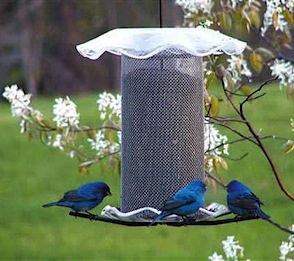 Spring migrations can bring the coolest birds around. Not that we don’t enjoy our resident bluebirds, cardinals, chickadees and other usual suspects, but there’s something really exciting when one of these migratory visitors graces your yard. When one thinks “finch” it’s commonly the house, gold, or purple finch (who’s more red than purple) that come to mind.
Spring migrations can bring the coolest birds around. Not that we don’t enjoy our resident bluebirds, cardinals, chickadees and other usual suspects, but there’s something really exciting when one of these migratory visitors graces your yard. When one thinks “finch” it’s commonly the house, gold, or purple finch (who’s more red than purple) that come to mind.These blue birds happen to be finches too. Indigo buntings’ vibrant plumage is just as electrifying as goldfinches’ lemony hue is during peak summer season. You’ll find buntings at finch feeders, and honestly it’s hard to miss that color. They go for tiny seeds found in finch mixes, as well as nyjer (or thistle) seed.
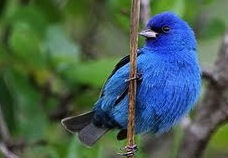 Their visits are always brief with us, moving further north for suitable breeding grounds. Painted buntings may also be seen at finch feeders, but we’ve spotted them only one time. So maybe it’s not the feeders themselves that are so colorful, but the spring migratory birds who frequent them… be on the look-out!
Their visits are always brief with us, moving further north for suitable breeding grounds. Painted buntings may also be seen at finch feeders, but we’ve spotted them only one time. So maybe it’s not the feeders themselves that are so colorful, but the spring migratory birds who frequent them… be on the look-out! -
The American Goldfinch and a Nyjer Feeder
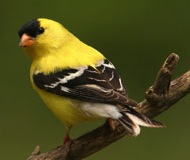 Goldfinches happen to be one of the latest nesters, we have always conveyed this, but never with the logic behind why this is so. The following appeared on ListServe and answers the question to a T. Pretty interesting stuff!
Goldfinches happen to be one of the latest nesters, we have always conveyed this, but never with the logic behind why this is so. The following appeared on ListServe and answers the question to a T. Pretty interesting stuff!I don’t know much about them, but I have heard that they wait to nest until dandelion thistle is available. Any truth to this?
“American Goldfinches are really interesting birds. I don’t think it’s understood scientifically, but they do time their nesting very closely to the flowering of the entire true thistle family, although they eat a wide variety of small seeds. (They aren’t dependent on dandelion seeds, since dandelions go to seed all season long.) They are almost completely dependent on a seed diet, even feeding their nestlings a seed slurry from their crops (unlike most songbirds–even the seed-eaters–which feed insects to their kids). In part, it is believed that they can feed seeds to growing nestlings because thistle seeds, easily plucked from a nyjer feeder, are so high in protein, compared to other seeds. We used to have a real struggle raising orphaned goldfinches in rehab until we understood the importance of the high protein content of the thistle seeds with which the babies grow up. We used to feed them a seed-based formula, since that’s what the adults do, and they typically failed to thrive. However, once we switched to the insectivorous formula (which doesn’t contain insects per se but has more protein than the seed-based formula does), many of the problems resolved.
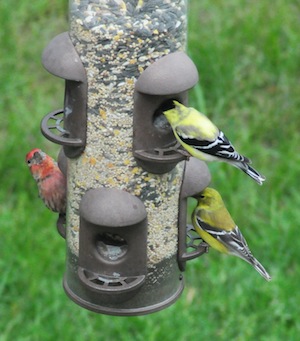
Goldfinches are known to eat small seeds other than those from a nyjer feeder This interrelationship with the thistle family makes American Goldfinches pretty much the latest avian breeder in North America, since thistles bloom very late in the season (late July and early August here). At the wildlife rehab center, you know the breeding season is coming to a close when you start to hear those incessant, piercing baby contact call notes ringing through the center halls, boring a hole into your so-totally-done-with-baby-bird-season brain. Music to my ears personally.
Not much action in the nest boxes in central Colorado, although we have one completed White-breasted Nuthatch nest and one that just needs the inner lining. Juniper Titmice and Mountain Chickadees are singing; I hear the downward “phew, phew” calls of Mountain Bluebirds moving around the property. The Golden Eagle in the rock cliff nest over the Arkansas River has been incubating for ~4 weeks, so chicks should hatch in the next couple of weeks. The American Dippers nesting at the bridge across the Arkansas are feeding noisy chicks and the adults are nearly a constant blur in and out of the river scarfing up aquatic insects for them all. Last week in Coaldale, we had ~10″ of snow (only 1-4″ predicted)
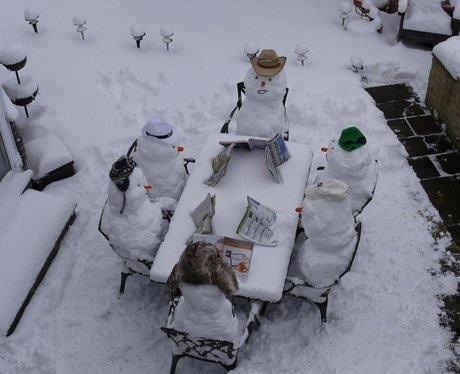 that had completely melted/evaporated 24 hours later. (Major snow dump on Tues.; on Thurs., I was checking nest boxes in shorts and a t shirt.) Now, here in the metro Denver area, we’re facing the possibility of 3 days of snow (a rarity here in the arid west) with 6-9″ forecast for us in the western ‘burbs and highs in the 30s those days. Back to winter for a while…”
that had completely melted/evaporated 24 hours later. (Major snow dump on Tues.; on Thurs., I was checking nest boxes in shorts and a t shirt.) Now, here in the metro Denver area, we’re facing the possibility of 3 days of snow (a rarity here in the arid west) with 6-9″ forecast for us in the western ‘burbs and highs in the 30s those days. Back to winter for a while…”Posted by Tina Mitchell, Coaldale, CO
